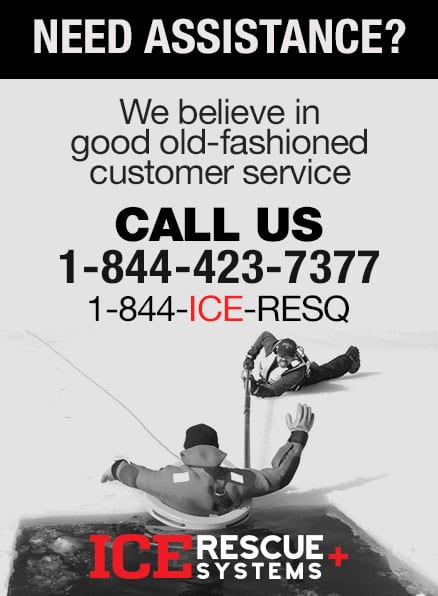Can the rescuer use the Tactical Reach Pole System? One of the first considerations of any ice rescue is the evaluation of the victim and the environmental conditions surrounding the incident. It is essential to evaluate the state of the victim before deciding which rescue method to use. Victim care is critical and should be a consideration when planning the rescue. The victim is handled with the utmost care as they are in a weakened condition due to exposure to extreme cold. We use the Rapid Transport Sled along with the Tactical Reach Pole System; this system allows the rescuer to execute a more extended reach rescue while providing an essential patient care platform. This system requires no setup and is ready to deploy when necessary. Communication is crucial; always talk to the victim throughout the rescue operation, let them know what you are doing and what you need them to do.
The ice is weak because a person or pet has broken through the ice and is now in the water. The rescuer must plan carefully, asking them self “is there open water to navigate? How is the weather? Is a person or an animal in the ice?” Remember we don’t want to break the ice around our victim; it may be the only thing keeping them from submergence. If a victim submerges and is under the ice shelf all is not lost the rescuer still has an opportunity to perform the rescue and give the victim a chance. The Tactical Reach Pole System comes with a grapnel attachment that can be used to snag a victim caught under the ice shelf.
It is essential to have the proper type of tools and equipment to perform the job effectively and efficiently in any rescue. Rescuers must always have the appropriate PPE for the job, “personal protective equipment,” that is of adequate design for exposure to the elements and extreme weather conditions. A personal floatation device (PFD) is always mandatory during an ice rescue with the use of a dry suit.
When executing any rescue long reach rescue is a safer alternative, because it minimizes the risk to the rescuer. The rescuer risk factor increases dramatically with an in-water rescue. Rescuers should try to avoid entering the water whenever possible, especially if a dog is in the ice and water. Dogs and people are in a high-stress environment, they are scared, and dogs will bite. In dog rescues it is important to be independent of the dog; the Tactical Reach Pole System is versatile equipped with attachments designed specifically for dog rescue, the DRD system (Dog Rescue Device) helps you keep your distance.
Can the victim be reached without the rescuer having to enter the water? It may be possible to rescue the victim with the Tactical Reach Pole alone; this system extends to thirteen feet even so; getting flotation to the victim is the essential first step. When the victim is buoyant, it reassures and calms them, and we know they are not going under, which gives the rescuer time to slow down and plan the next move. The Tactical Reach Pole System attached to the Pro Recon sling can be extended to reach approximately fifteen feet out to the victim.
It is crucial when traversing thin ice to disperse weight evenly and to stay off of the knees, remember the ice is fragile. The Rapid Transport Sled is designed to disperse the rescuer’s weight and provide a smooth ride back to shore for the compromised victim.
The Tactical Reach Pole System comes in a variety of lengths. The TRP is lightweight, buoyant, telescoping for more extended reach, stainless steel components, and compatible with the dog rescue device, self-rescue device, ice stability testing tool, RTS attachment kit available. The TRP comes with several attachments to meet all your long reach rescue needs. The Tactical Reach Pole System is an all season tool it can be used in swift water rescue incidents too, multiple uses for rescuers, victims, and dogs.


